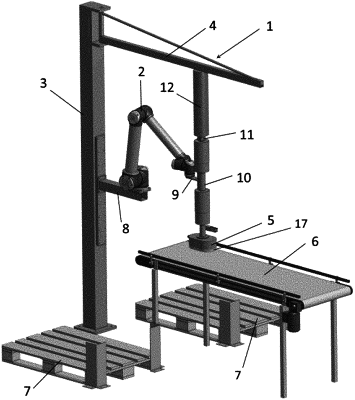| CPC B65G 47/91 (2013.01) [B25J 15/0616 (2013.01)] | 19 Claims |

|
1. A lifting device comprising a first unit (1) and a second unit (2), the first unit (1) configured to catch, hold, or both catch and hold an object and provide power for moving the object in a vertical direction, and the second unit (2) configured to control a vertical position of the object,
wherein the first unit (1) comprises:
a stationary vertically extending part (3), a horizontally extending part (4) and a lifting part (12) having a first attachment position and a second attachment position, at the first attachment position the lifting part (12) is attached or fixed to the horizontally extending part (4) and at the second attachment position the lifting part (12) is attached or fixed to a longitudinal member (11), the longitudinal member (11) comprising a catching part (5);
a sliding member (10) configured to slide in two directions between a first end position and a second end position along the longitudinal member (11), and an actual position of the sliding member (10) relative to the longitudinal member (11) configured to determine lifting power of the lifting part (12);
wherein the second unit (2) comprises a first attachment position and a second attachment position and
the first attachment position is fixed to the vertically extending part (3) of the first unit (1);
the second attachment position is fixed to the sliding member (10) of the first unit (1) by a rigid joint configured to transfer all movements induced at the second attachment position by the second unit (2) to the sliding member (10),
wherein the second unit (2) is configured to control a horizontal position of the object and the second unit (2) is configured to move relative to the horizontally extending part (4).
|